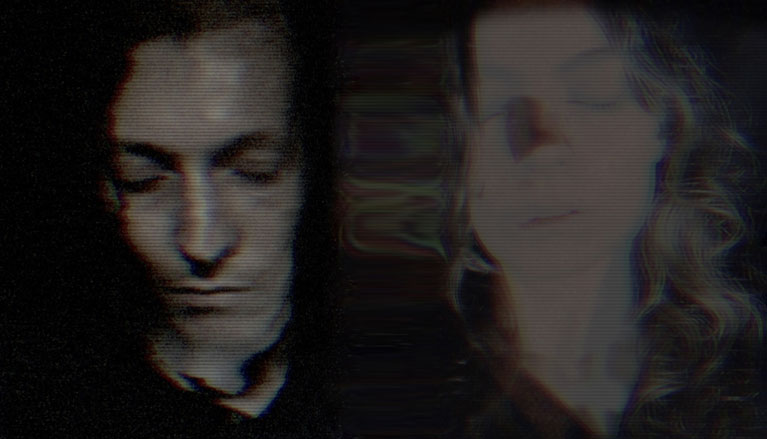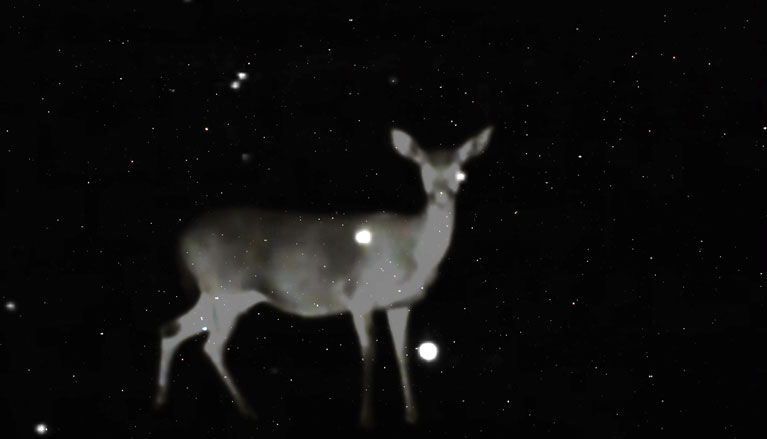Inaugurazione dell'installazione video-fotografica
Open from 18 to 21, from Tuesday 22 to Saturday 26.
Le porte regali (2015-2018), Coma Berenices (2018), Maria fuit hic (2020)
Each exhibition is a green room: it embodies the inherent desire to look back and celebrate the dead. Within this ideal room that rejects the present and excludes the future, we have arbitrarily brought together, thanks to our long-time friend Mauro Santini and the Pesaro Film Festival, three projects (Le porte regali, Maria fuit hic, Coma Berenices) that share a personal reflection on the often forgotten esoteric potential of the image.
Inspired, in part, by Pavel Florensky's reflections on art and dreams and by the essay with the same title on the icon that appeared in 1922, Le porte regali (The Royal Doors) is a triptych suggested by film critic Adriano Aprà for his FuoriNorma initiative – The neo-experimental way to Italian cinema. Composed of three works - Iconostasi, Psicopompo, and Dagadòl - it is our personal attempt to evoke a metaphysics of images and light, arbitrarily recalling the dividing structure between the presbyterial area and the area reserved for the faithful in the Orthodox Christian rite. The absolute protagonists of this epic of the gaze are the eyes and their capacity to be impressed, symbolically assisted by capricious demiurges poised between the sensible and the supersensible worlds: a ferryman of souls (Psychopompus), a Leviathan (Dagadól), and a painted partition with three doors (Iconostasis). Mesmerised by these hypothetical otherworldly guides, with the sole help of our gaze we can forget the self and cross the "royal doors" of the iconostasis, the gash that connects heaven and earth, the rope stretched between wakefulness and sleep, the place where things manifest themselves for what they are: products of light. There’s an invitation to abandon oneself, to sink down, to disobey the senses numbed by horror pleni, visual bulimia, and imaginative pollution.
The eyes and their ability to be impressed are also the protagonists of the photographic project Maria fuit hic, created using an extremely sensitive film stock made up of very large silver halide crystals. These are capable of producing a rarefied image, an incorporeal trace in the process of becoming. This intention stems from the desire to dissolve one's own identity, to get rid of it by taking on new features, at the same time testifying to its abandonment. Maria fuit hic, which takes up the Latin inscription by Jan Van Eyck in his famous Arnolfini Portrait, is in fact a collection of self-portraits conceived and staged inside a hypothetical green room in the style of Truffaut, capable of immortalising extemporaneously the multiple states of being: 'The me that I was, am and never will be'. Coma Berenices is its natural extension in video form, in which the subject denies itself to the gaze in order to be imagined and prolong its ephemeral existence in the rooms of memory. Just like that of the works hosted here (and others), which only partially relate to us. Their creation originates from a movement, from an intention assisted by a fifth hand, that of the invisible, which is embodied in the film-photographic medium.
Morgan Menegazzo, Mariachiara Pernisa

Morgan Menegazzo (Lendinara 1976) is a film director, author, and editorial coordinator. After his film studies at the D.A.M.S., Bologna University, he graduated in film directing at the Nuova Università del Cinema e Televisione (NUCT) in Cinecittà.
Mariachiara Pernisa (Lugo 1981) is an author, photographer, and film editor. After graduating from the academy of Fine Arts in Bologna, she specialized in film editing and photography at the Rome Accademia di Cinema e Televisione Griffith.
Their first work together was Hankgefmobility (2001), an independent multidisciplinary project that included videos, films, and documentaries. The couple’s works have been distributed theatrically and screened at the Rome Cineteca Nazionale, Hannover Biennale, and Rovereto MART and in festivals including Torino Film Festival, Pesaro Film Festival, Haverhill Experimental Film Festival, and Experiments in Cinema. They have also been broadcast by TV stations and satellite networks such as RAI, Al Jazeera, and Russia Today.
Mauro Santini
You have to nurture your inner darkness,
your shadows, and try to show their beauty.
I have always detested the light at midday,
and for me the current use of the digital recalls
this light that makes everything (over)exposed.*
Pesaro 2002, Teatro Sperimentale, video auditorium (not yet named Sala Pasolini): a very young couple of filmmakers present L’acqua che non pesa viene dal cielo. Here began a long season of retrospectives and sharing of ideas with Mariachiara and Morgan, who were to come back frequently to the Pesaro Film Festival in the following years, initially in the programmes curated by Andrea di Mario, and later in several editions of Satellite.
Their twenty-year-long research has always avoided not only mainstream film, but also experimental cinema showcases; standing wisely apart, just like their fair complexions keep away from the Pesaro summer sunlight. Almost two elves, or rather an elf and a fairy. And just like a fairy and an elf, Mariachiara and Morgan believe in the esoteric meaning of the image, in “the power of cinema to foreshadow other realities.”
Their career is characterized by a research of the sacred, or better the sacredness of the image. They pursue a perceptive pureness where the 4K, i.e., the excess of definition, fails. Their works are antithetical to the objective world – and its alleged representation by way of the concreteness of the digital – exposing the immaterialness of the format. They unravel its inauthenticity, transfiguring solid shapes into colours, sounds, lights, and shadows. Like psychopomps (or, I daresay, psychagogues), they conduct us to other worlds, even resorting to analogue technical devices, such as shooting through a pin hole. The media of cinema and photography are thus used as esoteric investigative tools.
The reflection on the values of the images is precise and constant, never merely an aesthetic one; once freed from the constraints of the representation of reality, they flourish along with the sounds, occupy the space and saturate it until they are unendurable.
Their necessity to overflow from the four sides of the screen is also the theme of this year’s exhibition at “spazio bianco”, which follows up on the show by Rossi/Cornelio, an artistic couple who also tend to exceed the showroom; and just as their photographs established a dialogue with the projection of a film trilogy, Mariachiara’s photos on the upper floor – a green room with portraits of a human being who never existed or has always existed – pave the way for visions/notes from underground.
*Mariachiara Pernisa, in “Il difetto è la verità della materia”. Coversation with Giorgiomaria Cornelio (Artnoise, October 2018)

